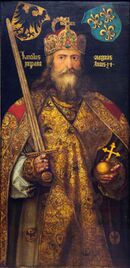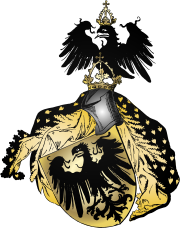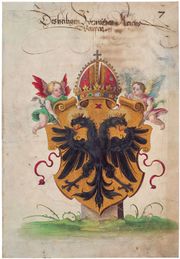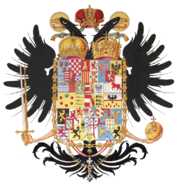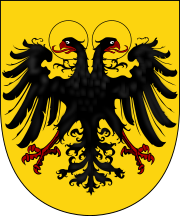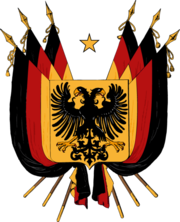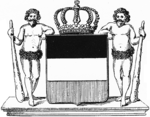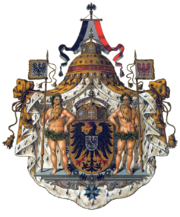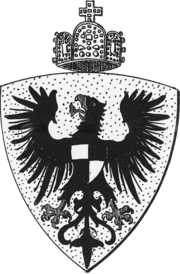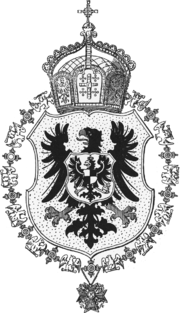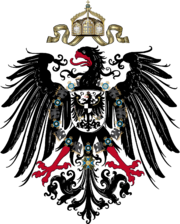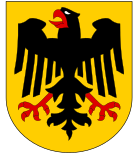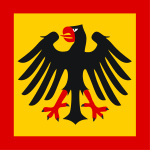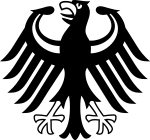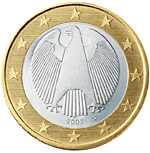درع ألمانيا
هذه المقالة بحاجة لمصادر إضافية لتحسين وثوقيتها. (March 2009) |
| Coat of arms of Germany | |
|---|---|
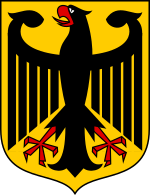 | |
| Versions | |
 The Eagle used by federal institutions | |
| التفاصيل | |
| Armiger | The German Federal Government |
| Adopted | May 23, 1949 October 3, 1990 (new coat of arms) |
| Escutcheon | Or an eagle sable, armed, beaked and langued gules. |
| النسخ السابقة | The current version of the coat of arms of Germany was introduced during the later days of the Weimar Republic |
The coat of arms of Germany is a sign of ألمانيا; the coat of arms features an eagle. The colours of the coat of arms are similar to those of the flag of Germany (black, red and gold). It is one of the oldest extant state symbols of Europe and is among the oldest insignia in the world.[بحاجة لمصدر]
Medieval Age and Holy Roman Empire
The history of the eagle as an emblem began very early. The Roman Empire and the Byzantine Empire reserved eagle imagery for only the most revered beings; namely, the supreme God and the emperor; and it served as a metaphor of invincibility. Later, through its imperial insignium of the golden eagle (cf. adler), referred to in German as the Reichsadler, on German soil probably date back to the time of Charlemagne (742–814). Around the year 1200 the black eagle icon on a gold field was generally recognised as the imperial coat of arms.
In 1433 the double-headed eagle was adopted for the first time by the Holy Roman Emperor Sigismund. Since then the double-headed eagle came to be used as the symbol of the German emperor, and hence as the coat of arms of the Holy Roman Empire of the German Nation. From the middle of the 15th century onwards, the respective emperors put the emblem of their dynasty on the eagle's chest.
After the end of the Holy Roman Empire of the German Nation in 1806, a German state and a unified state emblem ceased to exist.
| Coats of Arms of the Holy Roman Empire | |||
|---|---|---|---|
| Coat of Arms of Emperor Frederick III. as German King in 1446. | The Arms of the Holy Roman Empire of the German Nation in a manuscript | The Arms of Emperor Joseph II. (1765) | The Arms 1804 - 1806 under the last Emperor Francis II. (Emperor Francis I. of Austria) |
German Confederation
In 1815, a German Confederation (Bund) of 39 loosely-united German states was founded on the territory of the former German empire. Until 1848, the confederation did not have a coat of arms of its own. The Federal Diet (Bundestag) meeting at Frankfurt am Main used a seal which carried the emblem of the Austrian Empire, since Austria had taken over the union's leadership. It showed a black, double-headed eagle, which Austria had adopted just before the dissolution of the Holy Roman Empire of the German Nation.
During the 1848 revolution, a new Reich coat of arms was adopted by the German National Assembly that convened in St. Paul's Church in Frankfurt. The black double-headed eagle was retained, but without the four symbols of the emperor: the sword, the imperial orb, the sceptre and the crown. The eagle rested on a golden shield; above was a five-pointed golden star. On both sides the shield was flanked by two flags with the colours black-red-gold. The emblem, however, never gained general acceptance.
The coat of arms itself was the result of a decision of the federal assembly:
The federal assembly constitutes the old German imperial eagle with the surrounding scripture "German Confederation" and the colors of the former German emperial coat of arms - black, red, gold - to be the coat of arms and colors of the German Confederation and reserves the right, to make further decision about its use according to the lecture of the committee.
— The Federal Assembly of the German Confederation، Federal decision about coat of arms and colors of the German Confederation of March 19, 1848 [1]
| Coats of Arms in the times of the German Confederation | |||
|---|---|---|---|
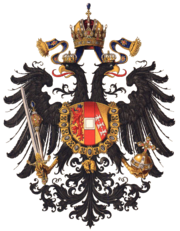
|
|||
| Imperial Eagle of Austria served as model for the Arms of the German Confederation | Coat of Arms of the German Confederation | Proposed Coat of Arms of the German Empire during the March Revolution 1848 | |
North German Confederation
In 1867, the North German Confederation was established without Austria and the southern German states, and under the leadership of the Kingdom of Prussia (see coat of arms of Prussia). A new coat of arms was adopted, which consisted of a shield with the colours black-white-red, flanked by two wild men holding cudgels and standing on a pedestal.
German Empire
The German Empire re-introduced the Medieval single headed eagle in a golden shield.
The so called Reichsadler, was already introduced at the Proclamation of Versailles, although the first version had been only a provisional one. The design of the eagle had been altered at least two times during the German Empire (1871–1918). It shows the imperial eagle, a realistic black eagle, with the crown of the Holy Roman Empire. The eagle has a red head and claws, with open wings and feathers, but only one head, looking to the right.This is in contrast to its predecessor, the eagle of the German Confederation, because it symoblised that important parts of the old empire, Austria and Bohemia, were not part of this new empire. Its legal basis was an imperial rescript:
To the Imperial Chancellor Prince of Bismarck. Following your report of June 27 of this year I authorize: 1. that public authorities and public servants, appointed by the Emperor according the requirements of the constitution and the laws of the German Empire, are to be called imperial; 2. that the black, one-headed, rightward-looking eagle with red beak, tongue and claws, without scepter and orb, on the breast shield the Prussian eagle, overlaid with the shield of the House of Hohenzollern, over the same the crown in the form of the crown of Charlemagne, but with two crossing bows, may be brought into use; 3. that the Imperial standard [Script continues]
— Kaiser Wilhelm، Rescript of August third, 1871, concerning the names of the public authorities and public servants of the German Empire, as well as the declaration of the Imperial coat of arms and the Imperial standard
Weimar Republic
The Weimar Republic (1918–1933), retained the Reichsadler without the symbols of the former Monarchy (Crown, Collar, Breast shield with the Prussian Arms). This left the black eagle with one head, facing to the right, with open wings but closed feathers, with a red beak, tongue and claws and white highlighting. The artistic rendition of the eagle was very realistic. This eagle is mounted on a yellow (golden) shield. The coat of arms was announced in 1919 by the President Friedrich Ebert and Interior Minister Erich Koch-Weser:
By reason of a decision of the Federal Government I hereby announce, that the Imperial coat of arms on a gold-yellow shield shows the one headed black eagle, the head turned to the right, the wings open but with closed feathering, beak, tongue and claws in red color. If the Federal Eagle is shown without a frame, the same charge and colors as those of the eagle of the federal coat of arms are to be used, but the tops of the feathers are directed outside. The patterns kept by the Federal Ministry of the Interior are decisive for the heraldic design. The artistic design may be varied for each special purpose.
— President Ebert; Minister of the Interior, Koch، Announcement concerning the federal coat of arms and the imperial eagle of November 11, 1919[3]
| دروع جمهورية ڤايمار (1919–1933) | |||
|---|---|---|---|
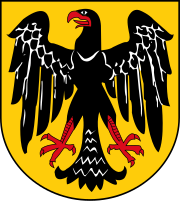
|
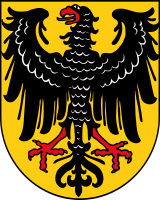
| ||
| Arms in the earlier days of the Weimar Republic | Arms used in the governmental flags of the Weimar Republic | ||
ألمانيا النازية
Adolf Hitler came to power in 1933, but the Weimar eagle was retained until 1935. The Nazi Party used a rather aggressively styled black eagle above a highly stylised oak wreath, with a swastika at its centre. When the eagle is looking to its left shoulder, it symbolises the Nazi party, and was therefore called the Parteiadler. After 1935 the Nazis introduced their party symbol as the national insignia (Hoheitszeichen) as well. This version symbolises the country (Reich), and was therefore called the Reichsadler. It can be distinguished from the Parteiadler because the eagle is looking to its right shoulder. The emblem was established by a regulation made by Adolf Hitler, November 1, 1935:
To express the unity of party and state in relation to their emblems too, I decide:
Article 1 The empire holds as emblem of its nationality the national emblem of the National Socialist German Workers Party.
Article 2 The national emblems of the Wehrmacht remain intact.
Article 3 The announcement concerning the imperial coat of arms and the imperial eagle (Reichsgesetzbl. Pg 1877) is cancelled.
Article 4 In agreement with the Representative of the Führer, the Imperial Minister of the Interior will enact the regulations necessary to implement article 1.— The Führer and Imperial Chancellor Adolf Hitler (and others)، Regulation concerning the national emblem of the empire of November 5, 1935 [4]
Hitler added on March 7, 1936, that:
In relation to the Regulation concerning the national emblem of the empire of November 5, 1935, article 1 I decide: The national emblem of the Empire shows the swastika, surrounded by an oak wreath, on the oak wreath an eagle with spread wings. The head of the eagle is turned to the right. For the heraldic design of the national emblem, the included patterns are decisive. The artistic design is varied for each special purpose.
— The Führer and Imperial Chancellor Adolf Hitler (and others)، Regulation concerning the design of the national emblem of the empire of March 7, 1936 [5]
| Insignia during Nazi-rule (1933–1945) | |||
|---|---|---|---|

| |||
| The Reichsadler during the time of Nazi rule, representing Nazi Germany as a national insignia (Hoheitszeichen) since 1935 | |||
Post-War Era
The Federal Republic of Germany adopted the Weimar eagle as its symbol in 1950. Since then it has been known as the Bundesadler ("federal eagle"). The legal basis of the use of this coat of arms is the announcement by President Theodor Heuss, Chancellor Konrad Adenauer and Interior Minister Gustav Heinemann of January 20, 1950, which is word for word identical to the announcement by President Friedrich Ebert and Interior Minister Erich Koch-Weser by November 11, 1919:
By reason of a decision of the Federal Government I hereby announce that the Federal coat of arms on a gold-yellow
shield shows the one headed black eagle, the head turned to the right, the wings open but with closed feathering, beak, tongue and claws of red color. If the Federal Eagle is shown without a frame, the same charge and colors as those of the eagle of the Federal coat of arms are to be used, but the tops of the feathers are directed outside. The patterns kept by the Federal Ministry of the Interior are definitive for the heraldic design. The artistic design is reserved to each
special purpose.
— The Federal President Theodor Heuß, The Federal Chancellor Adenauer, The Federal Minister of the Interior Heinemann، Announcement concerning the federal coat of arms and the federal eagle. [6]
The design by Tobias Schwab dates from 1926. Since the accession in 1990 of the states that used to form the German Democratic Republic, the Federal Eagle has been the state symbol of the reunified Germany.
جمهورية ألمانيا الديمقراطية
 مقالة مفصلة: Coat of arms of the German Democratic Republic
مقالة مفصلة: Coat of arms of the German Democratic Republic
The German Democratic Republic (East Germany) used a socialist insignia from 1950 until its reunification with West Germany in 1990. In 1959 the insigna was also added to the Flag of East Germany.
| Insignia of the German Democratic Republic | ||
|---|---|---|
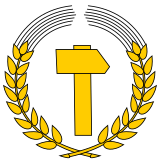
|
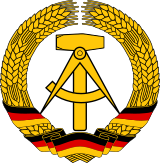
|
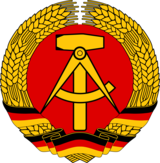
|
| Coat of Arms of East Germany 1950–1953 |
Coat of Arms of East Germany 1953–1955 |
Coat of Arms of East Germany 1955–1990 |
Current usage
Official depictions of the eagle can be found not only in the federal coat of arms but also on the federal institutions flag, the standard of the President of Germany and official seals. These are designs by various artists of the Weimar period and differ primarily in the shape and position of the wings. A large and very plump version of the eagle decorates the chamber of the Bundestag, the German parliament, it is sometimes called "Fette Henne" (Fat Hen), with a similar representation found on the Euro coin. In addition to the official depictions, artistic renderings of the federal eagle are permitted and have found their way onto coins, stamps and the letterhead of federal authorities.
Gallery of variants
| The federal coat of arms (Bundeswappen) of the Federal Republic of Germany | The federal escutcheon (Bundesschild) used on the German State Flag and on military standards | The Standard of the Federal President | The Eagle used by federal governmental institutions | The Eagle on the German Mark coin (until 2002) | The Eagle on the German 1 euro coin |
|---|
الهامش
- ^ the German Confederation, The Federal Assembly of (1948-3-9). Bundesbeschluß über Wappen und Farben des Deutschen Bundes Bundesbeschluß über Wappen und Farben des Deutschen Bundes vom 9. März 1848. Federal decision about coat of arms and colors of the confederation of German states of march 9, 1848. Frankfurt.
{{cite book}}: Check|url=value (help); Check date values in:|date=(help); Cite has empty unknown parameter:|coauthors=(help) - ^ von Hohenzollern, Wilhelm (The German Emperor and King of Prussia) (1919-11-11). Allerhöchster Erlass vom 3. August 1871, betreffend die Bezeichnung der Behörden und Beamten des Deutschen Reichs, sowie die Feststellung des Kaiserlichen Wappens und der Kaiserlichen Standarte (Rescript of August 3th, 1871, concerning the names of the public authorities and public servants of the German Empire, as well as the declaration of the Imperial coat of arms and the Imperial standard). Berlin. pp. Reichsgesetzblatt 1871. Nr. 681 Pg. 318 and 458.
{{cite book}}: Cite has empty unknown parameter:|coauthors=(help)CS1 maint: location missing publisher (link) - ^ Ebert, Friedrich (1919-11-11). 1919 Bekanntmachung, betreffend das Reichswappen und den Reichsadler (11.11.1919) Bekanntmachung betreffend das Reichswappen und den Reichsadler (Announcement concerning the imperial coat of arms and the imperial eagle). Berlin.
{{cite book}}: Check|url=value (help); Unknown parameter|coauthors=ignored (|author=suggested) (help)CS1 maint: location missing publisher (link) - ^ Hitler, Adolf (The Führer and Imperial Chancellor) (1935-11-1). 1935 Verordnung über das Hoheitszeichen des Reichs (05.11.1935) Verordnung über das Hoheitszeichen des Reichs vom 5. November 1935 (Regulation concerning the national emblem of the empire of November 5th, 1935). Berlin.
{{cite book}}: Check|url=value (help); Check date values in:|date=(help); Unknown parameter|coauthors=ignored (|author=suggested) (help) - ^ Hitler, Adolf (The Führer and Imperial Chancellor) (1936-3-7). 1936 Verordnung über die Gestaltung des Hoheitszeichens des Reichs (07.03.1936) Verordnung über die Gestaltung Hoheitszeichen des Reichs vom 7.März 1936 (Regulation concerning the design of the national emblem of the empire of March 7th, 1936). Berlin.
{{cite book}}: Check|url=value (help); Check date values in:|date=(help); Unknown parameter|coauthors=ignored (|author=suggested) (help) - ^
Heuß, Theodor (The Federal President of the Federal Republic of Germany) (1950-1-20). Bekanntmachung betreffend das Bundeswappen und den Bundesadler (Announcement concerning the federal coat of arms and the federal eagle). Bonn.
{{cite book}}: Check date values in:|date=(help); Unknown parameter|coauthors=ignored (|author=suggested) (help)
Literature
- Ströhl, Hugo Gerard: Deutsche Wappenrolle, Stuttgart 1897 (Reprint Cologne - ISBN 3-89836-545-X)
- Laitenberger, Birgit; Bassier, Maria: Wappen und Flaggen der Bundesrepublik Deutschland und ihrer Länder, 5th revised edition, Cologne 2000 - ISBN 3-452-24262-5
انظر أيضاً
- CS1 errors: URL
- CS1 maint: location missing publisher
- CS1: Julian–Gregorian uncertainty
- CS1 errors: unsupported parameter
- Articles needing additional references from March 2009
- All articles needing additional references
- مقالات ذات عبارات بحاجة لمصادر
- Articles with hatnote templates targeting a nonexistent page
- National symbols of Germany
- German coats of arms
- National coats of arms
